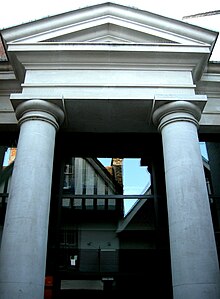Roman Museum

Entrance in Butchery Lane, Canterbury
|
|
| Established | 1961 1994 after refurbishment |
|---|---|
| Location | 11a Butchery Lane, Canterbury, Kent, CT1 2JR |
| Type | Scheduled monument, heritage centre |
| Collection size |
Roman pavement; excavated Roman artefacts |
| Director | Jo Jones |
| Public transit access | Rail: Canterbury West; Canterbury East Buses: National Express; Stagecoach; Canterbury bus station |
| Website | Canterbury City Council Online: Canterbury Roman Museum |
The Canterbury Roman Museum in Canterbury, Kent, houses a Roman pavement which is a scheduled monument, in the remains of a Roman courtyard house which itself is a grade I listed building. The pavement was discovered after World War II bombing, and has been open to the public since 1946. The museum was established in 1961, but it has been under threat of closure as of 2009. It houses many excavated artifacts from Roman Canterbury, including the important late Roman silver hoard known as the Canterbury Treasure, together with reconstructions of the Roman town.
In the first century AD the Cantiaci were the inhabitants of Kent when the Romans captured a settlement on the River Stour and later called it Durovernum Cantiacorum, or stronghold of the Cantiaci by an Alder marsh. The new settlement was laid out as a partially grid-patterned town with a theatre, temple, forum and baths. In the late third century, to defend against attack from barbarians a town wall was built with seven gates. The town then covered 130 acres or 53 hectares.
Roman Canterbury reached the height of its development around 300 AD. The Roman townhouse which contained the pavement was surrounded by public buildings. The temple precinct was partially excavated in 1976-1982, but the temple itself was not found. The townhouse associated with the pavement may have been used until about 410 AD when the Roman administration left Britain.
...
Wikipedia
